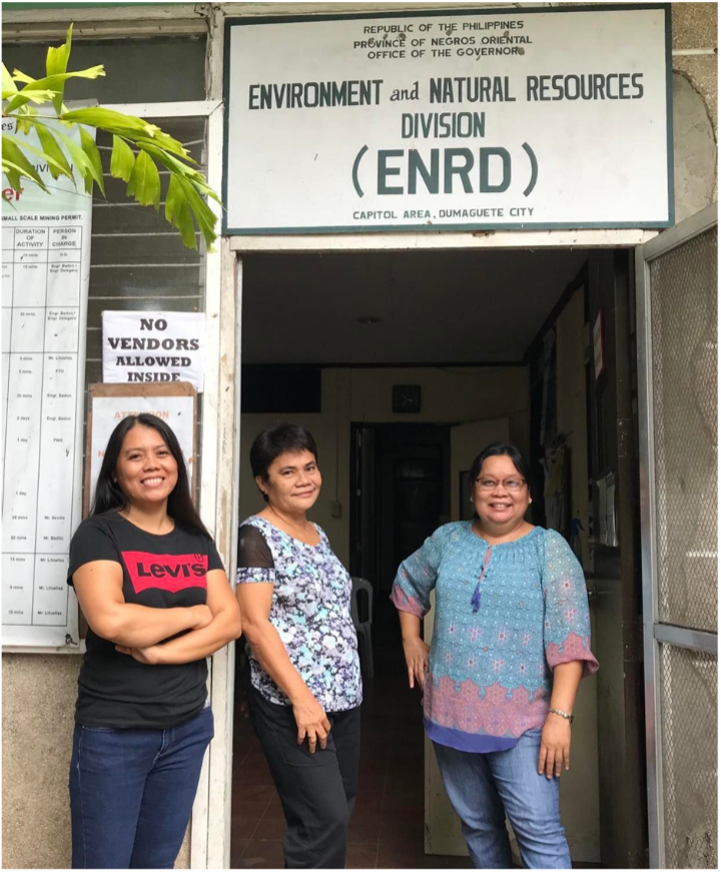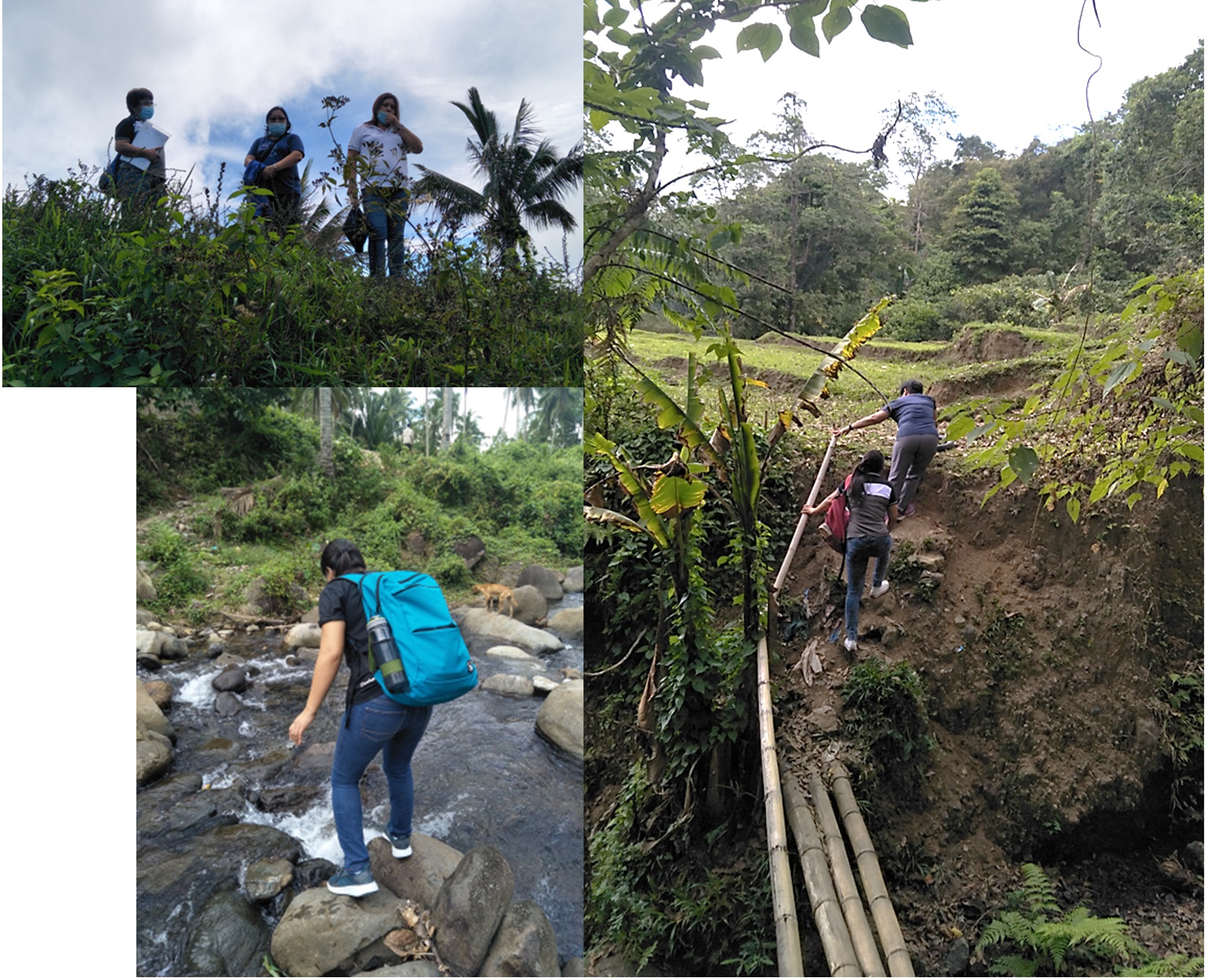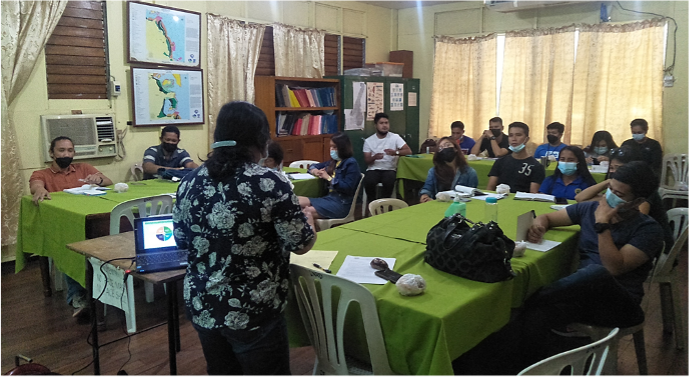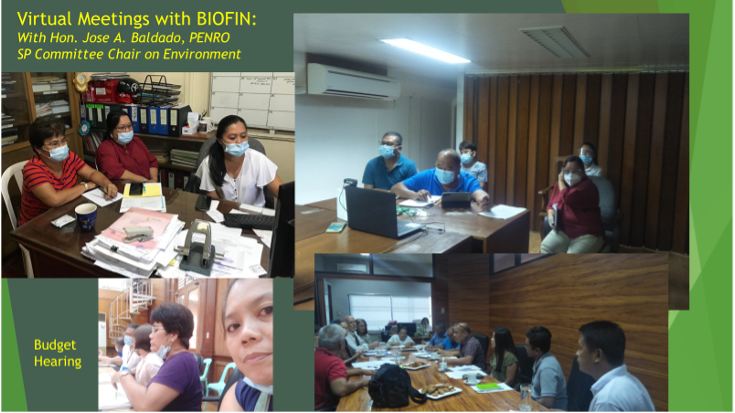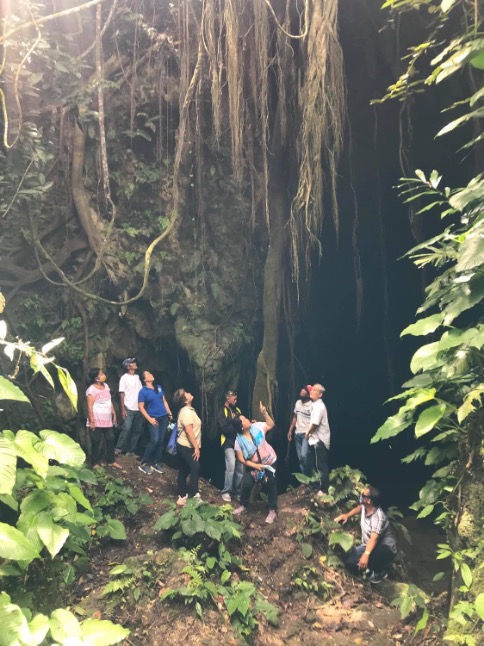by Wilma Rojas (BIOFIN Gender Specialist) with assitance from Winnie Velasquez
Women Champions of Biodiversity Financing in Negros Oriental Province
March 28, 2022
Left to right: Vicky Mari, Mercy Balbon, Anabele Barillo
No Mountain High Enough
‘Ain’t no mountain high enough
Ain’t no valley low enough, ain’t no river wide enough
To keep me from getting to you...
This Marvin Gaye song popularized by Diana Ross in the ‘70s could very well be the theme song of Vicky S. Mari, Anabele B. Barillo, and Mercy R. Balbon who have been dubbed as the Tres Marias of Negros Oriental Province’s biodiversity.
These biodiversity officers of the Environment and Natural Resources Division of the Provincial Government of Negros Oriental, climb mountains, cross rivers, hike through muddy and rough terrain, brave inclement weather, and face security risks to carry out their work with very little budget and meager resources.
“Transportation is a major problem. There is only one new vehicle, the rest are vintage and we have to share it with the other divisions in the provincial office.
If they have more important assignments, we can’t go to the LGUs right away to check on our programs. We ride a bus but some eco-tourism sites in the hinterlands cannot be reached by bus so we ride the habal-habal,” Vicky and Mercy said. “We find ways,” Anabele added.
A common thread binds the three women — a love for nature and dedication to their work.
“I love my work. I love my job. Maski gaano kahirap sa bundok na puntahan namin, tawa lang kami nang tawa. Hindi namin iniintindi kahit na madulas kami, gumulong sa putikan. (No matter how hard it is in the mountains, we just laugh and laugh. We do not mind it even if we slip and roll in the mud.) We accept the challenge. Enjoy lang kami. Kasi kung hindi mo enjoy ang trabaho mo, hindi mo love ito, palagi ka nalang bubulong-bulong at nagrereklamo,” Mercy said. (We just enjoy because if you do not enjoy your job and do not love it, you will always be murmuring and complaining.)
Before 2017, there was no specific blueprint for biodiversity conservation in the province. It was just integrated into the programs for climate change, coastal areas and watershed protection, wildlife conservation, and waste management. Thus, there was no budget allocation for it in the province’s annual investment plan.
How it all began
Marine biologist Anabele was a scuba diver in her younger years. She started as a research assistant to a foreign consultant of the environment and natural resources division and was one of the early members of the team that established the marine protected areas. She had previously worked in organizations implementing coastal resource management programs.
Anabele has been in government service for 31 years but became permanent only after 15 years as a job order employee. Attaining security of tenure in government service usually takes a long time. “But I because I enjoyed my work.”
Mercy on the other hand, has worked in the provincial government for more than 20 years. At the start, she was assigned to administrative work but when her boss saw that she can also do work in the mountains, she was transferred to the division.
“I took units in forestry while in college. My father died early so my sister and I were challenged. Kung ano ang ginagawa ng lalaki dapat kayanin ko rin,” she said. (Whatever the men could do, I should be able to do as well.)
Vicky has been with the division for 16 years. Fresh from college, she applied and was among those in the second batch of applicants who were hired. Taking up forestry — usually a course more men took— was a natural choice for her. “I was born in the mountains and grew up there. I am also super happy with our work here. I can’t imagine myself at a desk job.”
The trio for biodiversity work well together. Vicky is in charge of the uplands, Anabele takes care of more than 50 locally managed marine protected areas, and Mercy handles finance. “Siya ang magaling sa pera,” Anabele said. (She is good with money.)
“We have distinct responsibilities and go our separate ways but for matters involving wildlife, and for joint activities, we work together,” Vicky said.
“We were destined to work as a team, the three of us. We enjoy each other’s company and are able to adjust to one another. We have different personalities but we accept each other because we are flexible enough,” Anabele said.
“Walang iwanan. We started this together, we will finish this together,” the trio said.
Finding the money
In 2018, Vicky and Mercy attended a series of seminar workshops organized by BIOFIN. The things they learned during those workshops were a revelation, starting with a realization that they were working on a pittance of a budget compared to other provincial governments that took care of even much smaller protected areas. We were disheartened to see the big delegations of the other provinces who also had much larger budgets to present, we were working on a P300,000 allotment in 2017. When we got home I said, nakakahiya, ang liit ng aming budget,” Vicky said. (I felt embarassed, we had such a small budget.) She was crying (umiiyak siya), recount Anabele and Mercy,
But, after that initial reaction, the team’s never-say-die attitude prevailed.
“We were challenged to find a way to increase our budget. We were so used to working with what little we had. Kung ano lang meron pagkasyahin. This negative aspect of our operations became a challenge to us. We were determined to participate in the financial planning workshops of BIOFIN till the end and to prioritize preparation of our finance plan. We completed this in less than a month,” Anabele said.
“Lalaban kami. (We will fight). We are committed to what we are doing because we know we are on the right path,” she added.
“We are very grateful for the guidance of BIOFIN. They were very patient and persistent in helping us complete the biodiversity finance plan,” Vicky said.
Armed with their new knowledge on the biodiversity financing methodology and with mentoring support from BIOFIN, these women set out to work, consulting with key persons in their local government, and came up with a provincial biodiversity plan and a costing (financial plan). The exercise brought to light the province’s need of P1 billion to be able to implement a ten-year biodiversity plan (2018-2028). It was the first time the Negros Oriental provincial government had a distinct biodiversity plan because there was poor understanding and appreciation of biodiversity as an approach to environmental conservation.
Mercy took the reins in finding the money, Anabele did her part on lobbying with key officials to ask for support, and Vicky coordinated their advocacy efforts. From a P300,000 budget in the past, allotment for provincial biodiversity activities was increased to P1 million in 2019 in the Annual Investment Plan, and P2 million in 2021. Allocation has increased expenditure on infrastructure capital, human resource and social mobilization activities in protected areas, such as the building of tourist information centers, a canteen where local women tend a snack bar, loans for transport business capital by male boatmen/tour guides, honorarium for Bantay-Dagat/Gubat volunteers (mostly males), housing for a number of local resident-employees of protected areas, as well as local capacity building (training) and awareness raising activities.
Finding the money was not as easy as expected. Vicky did the legwork rolling out training on BIOFIN methodology to municipal environmental officers so that they could formulate a localized biodiversity plan and finance plan. At the beginning, it was unclear to her how localization of the BIOFIN methodology can facilitate the mobilization of resources for the conservation of Negros Oriental’s biodiversity. With BIOFIN’s guidance and help from the NGO Philippine Biodiversity Conservation Foundation, Vicky, Mercy and Anabele applied their learnings on how to close the gap in financing the biodiversity plan.
In addition to gaining the support of officials at the provincial level, they had to provide technical assistance and influence municipal level officials to prepare a counterpart municipal biodiversity plan. They gave advice on how to finance the plan from mandatory allotments that their LGU already had, and identify potential sources of additional revenues.
The BIOFIN methodology has been rolled out to the local government municipalities that have since formulated their local biodiversity plans, among them: Santa Catalina, Basai, Siaton, Dawin, and Zamboangita; and to date seven barangays have successfully passed resolutions to localize their municipalities’ biodiversity plans.
To date, the team has costed its priority programs (51 actions across the 20 PBSP Targets) amounting to P354,269,330 from 2020 to 2028. With their dedication and persistence, Negros Oriental now serves as a model for nearby Cebu and Negros Occidental provinces in terms of mainstreaming biodiversity into local plans through the BIOFIN methodology.
With advise from BIOFIN, they pushed for the formation of a technical working group (TWG) to forge partnerships and synergize actions . In April 2021, the governor issued an executive order for the creation of the TWG, though its take-off has been delayed by the Covid 19 pandemic. In this TWG, provincial units and national government agencies on tourism, agriculture, budget, environment and natural resources, energy, education, and peacekeeping, among others, will be represented. Civil society players, the private sector (businesses) and academe will also part be of the TWG. However, there are yet no specific provisions on representation of vulnerable groups such as women, elderly, youth, PWDs, farmers and the poor. Identifying and working with partners is an important building block in establishing a biofinancing mechanism, and for this the Tres Marias looks inwardly to bring to the fold more biofinancing champions from within their government unit. The private and civil society sectors likewise carry great potential for augmenting resources and strengthening public support.
Success of their story is not limited to increasing allocation of resources for biodiversity from the Annual Investment Plans, they have also proposed policy changes to the Sangguniang Panlalawigan. BIOFIN has provided a template for an ordinance that would impose an environment fee in tourist-servicing establishments such as hotels, transport carriers, etc. This policy proposal is already in the Sangguniang Panlalawigan and if passed, it is projected to raise about P14 million.
Challenges in the field
The three women said that except in the area of physical strength, the women can perform as well as or even better than their male counterparts.
For example, in biodiversity monitoring in the mountains, they said it is easier for the men because they walk faster and have more endurance.
“But this is only because we are older. Noong bata-bata pa kami, kaya namin silang sabayan,” they said. (When we were younger, we could match them stride by stride.)
They also qualified that when it comes to the level of difficulty they encounter in the field, there is a difference in the way they react to situations they are confronted with. Both the men and women face security threats in the hinterlands where they come face to face with insurgency.
Recounting the time she traveled to a mountain area heavily infested with NPA rebels, Vicky said the men remained calm throughout the ordeal but she had a hard time holding back her tears and keep from shaking in fear. Many residents of protected areas are also former active members of the NPA, and they are quite resistant to rules restricting the use of natural resources there because as long-time residents they feel they have intrinsic rights over the place even before the NIPAS law came into place.
She added that women communicate with people in the community better than the men. Because of the language we use, the way we talk, they listen to us more. “Mas pinakikinggan kami. There is greater respect.”
Mercy said that they do not encounter any problems working with their male colleagues “There is mutual respect and we can easily talk to them when we lobby for appropriations. The chairperson of the environment committee of the Sangguniang Panlalawigan, Councilor Jose Baldado, is also very supportive of our endeavors.”
In the area of program implementation, Vicky said the women have the advantage because they are more detailed and meticulous than the men, especially when it comes to safeguarding the money. Women are also more diligent at the workshop level, particularly in writing reports. The only problem is they tend to have more difficulty making female local government staff commit resources or cooperate in joint tasks. Mas madali kausap ang lalaki, (It is easier to talk to the men) but she also realizes that women are still a minority (only about 30 percent) of those working in the environment sector, and are not high in the hierarchy to be able to make quick decisions by themselves.
Aside from security risks and the difficulties they encounter in the field, the women also said that being away from their families for days, weeks, or even months, poses a challenge as well.
“When I am not able to go home for some time, my husband exclaims, ‘Wala ka ng asawa. Magagalit siya. Magagalit din ako. Pero ganoon lang yon, lumilipas din. Alam naman niya noong mag-asawa kami na yoon ang trabaho ko,” Mercy said. (You have no more husband. He gets angry, I get angry too, but it soon passes. He knows that when we married that was already my work).
“Hindi nila maintindihan minsan, (Sometimes they do not understand), but they have to accept it,” Vicky said.
Anabele has a different experience. “Sometimes I am away for a month, but my husband understands. He knows the work that I do because I met him in the office.”
Asked if there is a gender and development (GAD) focal point person in their division, Anabele said there is one but they have not linked up with the person. “It will be a big help to Negros biodiversity if we can work together.”
However, she added that gender was tackled in a fisheries management planning workshop co-organized with the Silliman University, wherein majority of the participants were men.
The team is looking forward to a partners’ forum that was postponed because of the pandemic. “We hope it will push through in December because that is where we can find the money from our partners. We have already identified some private individuals, a bus company and other donors we can tap, Anabele said.
The COVID-19 pandemic has delayed implementation of the biodiversity plans since tourism has slowed down. The province’s biodiversity-rich tourist attractions, such as the Balinsasayao Twin Lakes Protected Landscape and Seascape and Apo Island Natural Park have been receiving fewer visitors hence, revenues have declined. About two thirds of local residents who were employed in ecotourism related jobs in these areas have already lost their livelihood.
Another factor that has slowed down implementation of the province’s biodiversity plan is the upcoming elections in May 2022. As incumbents prioritize activities involving constituent consultations to increase their visibility in order to be able to win more votes for (re)election, mobilizing for long-term results such as biodiversity activities, have taken a back seat.
Passing on the torch
The team has also proposed hiring additional professional staff for their office and recruitment of female technical personnel such as biologists, foresters, and chemistry graduates, since women still make up less than half of their all specialists. There are about nine new entrants in their office, and four of them are women.
“We see to it that the new recruits, regardless of gender, have equal opportunity to participate in seminars and planning workshops so they can learn from us and know the different aspects of implementing the biodiversity program for the province. They are happily training with us and we hope they can continue our work in the future. We emphasize to them that it is crucial to understand the importance of biodiversity conservation so they can be committed to the job,” Anabele said.
Theshoulders of the Tres Marias. They serve as the secretariat of the Biodiversity program for the entire province — facilitating, coordinating, initiating activities to move the program forward until they finally close that financing gap.
### ###

 Locations
Locations